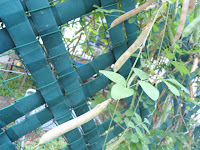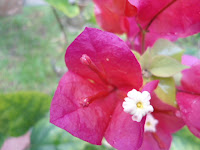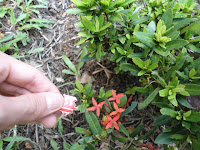This science nature trail is a practical for us to examine the structures of the carpel and stamen in different plant (flower) species. Through this practical, we can alos study the mode of pollination in different plant (flower) species. We took a walk aroudn the school campus and were tasked to look for 4 species of plants with insect-pollinated flowers and 2 species of plant with wind pollinated flowers. We were also given a hand lens to examine the carpel and stamen of the flowers and note the features and positions of the carpel and stamen in the flowers. Last but not least, we had to take pictures of each flower and research on each of the various plant species.
1. Flame of the Forest
• Scientific Name: Butea monosperma
• Information:
- Originated from Madagascar
- Discovered by Botanist Wenzel Bojer in 1820
• Description:
- Flowers grow in dense clusters
- Flame-coloured and faintly scented
- Fruits are long pods, dangling down sword-like
• Animal Pollination: Birds
- Petals brightly coloured
- Nectar
- Funnel-shaped to enable the bird to sip the nectar
- Stigma sticky
• Capable of both self and cross pollination
• Uses:
- Planted as an ornamental tree in parks, gardens and along roads as they are spectacular and beautiful when in full bloom
- Broad umbrella-shaped crown makes it a good shade tree
- Bark can be used as a cooling drink to prevent fevers
Here are some photos of the Flame of the Forest:
2. Frangipani
• Scientific Name: Plumeria
• Mode of Pollination: Insects
• Features:
- Large, brightly coloured petals
- Small stigmas that does not protrude out of flower
- Scented
• Explanation:
- Most fragrant in the evening to attract the moths, which come in search for nectar. But the flower has no nectar. So the moths would unintentionally pollinate the flower while trying to search for the nectar.
Here are some photos of the Frangipani:
3. Hibiscus
• Scientific Name: Hibiscus rosa-sinensis
• Mode of Pollination: Birds, Insect
- Insect/Animal Pollinated
- Pollinated by butterflies, but mostly by hummingbirds
• Features:
- Large, brightly coloured petals
- Nectar present
• Explanation:
- The birds hover at the bloom, draw nectar with their long and slender bills, and transfer pollen by coating themselves with it via their flapping wings.
Here are some photos of the Hibiscus:
4. Morning Glory
• Scientific Name: Ipomoea indica
• Mode of Pollination: Insect
- The Morning Glory opens in the morning and closes at night.
- Why? In the daytime, it is more likely that insect pollinators would be visiting the flowers. At night it is less likely that these insect pollinators will come. Through natural selection, the plant has learnt that opening in the morning is more ‘successful’ than opening at night. Therefore over time, the plant has evolved with this feature.
• Information:
- Morning Glory has creeping stems.
- This can potentially cause a serious weed problem.
- Morning Glory Seedpods
Here are some photos of the Morning Glory:
 |
| Morning Glory Seedpods! |
5. Bouganvillea
• Scientific Name: Bougainvillea Gabra
• Pollinated by Insect (like bees)
• Adaptation for mode of pollination:
- Although mode of pollination is by insects, its flowers are small and has no fragrance
- This is compensated by the plant transforming the buds near them to resemble blossoms. These have colorful petals and attract the bees.
Here are some photos of the Bouganvillae:
6. Ixora
• Scientific Name: Ixora coccinea
• Mode of Pollination: Animals
- Birds (Hummingbird)
- Insects (Butterfly)
• Adaptation for Pollination
- Produced in clusters
- Has long floral tubes
- Brightly colored
- Produces hard, fleshy berries
Here are some photos of the Ixora:
7. Dandelion
• Scientific Name: Taraxacum officinale
• Information:
- Originated from Europe and Asia
• Description:
- Golden yellow flowers
- Round, fluffy seed head
• Mode of Pollination: Wind
- Feathery seeds produced to be dispersed by wind
- Small and light
• Capable of both self-pollination or cross-pollination
• Uses:
- Dandelion leaves are used to add flavour to salads, sandwiches, and teas, to help the body get rid of excess fluid
- Roots are mainly used as an appetite stimulant, and for liver and gallbladder problems
- Flowers are used to make wines
• Video: http://www.britannica.com/EBchecked/media/16679/Dandelions-are-capable-of-both-self-pollination-and-cross-pollination
Here are some photos for the Dandelion:
8. Mimosa
• Scientific name: Mimosa pudica
• Mode of pollination: Wind
- The Mimosa closes its leaves when touched or exposed to other stimuli like fire and wind.
- Why? It is the result of the internal movement of water. A stimulus triggers certain areas of the stem to release chemicals, which cause water to move out of cell vacuoles and leads to cell collapse. This is an act of defence against herbivores.
- Mimosa is widely used in traditional medicine, because of its medicinal properties. It can even be used to combat glandular tumours and uterine cancer!
• Mimosa plant is easily found, and can cause weeding problems because of its prickles on its stem.
Here are some photos of the Mimosa:
Reflection of Science Nature Trail:
First of all, we are thrilled by the experience to step away from the world of the textbook into the amazing world of nature. The textbook is limited in its knowledge, it has its borders, only after I have stepped out of these borders, that we can see science and nature in front of my eyes, instead of a text. The dull words and printed pictures can never come close to the plethora of flora and fauna that nature has to offer. Overall, it was a truly enriching experience. From this amazing experience of the nature trail, we have learned and experienced many things.
First of all, it was amazing to go out and take pictures of these plants. This trip has opened our eyes and now we observe things in a different light. It was very interesting to look at flowers, identify their features to deduct its method of pollination, it definitely was better than reading it in a book. This has increased our analytical skills as well as allowed be to come close to how science works in nature. This experience was worth the amount of mosquito and ant bites we had to endure.
Secondly, we now know many more types of plants. For example, the ixora, the flame of the forest, petunias, bouganvillas, frangipanis, dandelions and mimosas. We were amazed at the diversity of plants we have in Hwa Chong. We even found some cucumber plants. When we walk around in Hwa Chong now, we will instantly try to take a closer look at the plants just to see what type of plant it was and how it pollinated etc.
Thirdly, we feel that this trail truly brings out the passion towards science in us. Science is how things work. We cannot simply observe how things work just by reading textbooks or staying in the constrained boundaries of the classroom. We must go out and observe for ourselves, feel for ourselves. Thus, we feel that this was a memorable experience and I hope to have more activities like such.
Lastly, we would like to end off with an excerpt from Daffodils by William Wordsworth: And then my heart with pleasure fills, and dances with the daffodils.
Nature, what pleasure and knowledge we can gain.
Done By: Ooi Ren Yi (2A120)
Lam Zhi Yuan (2A107)
Brandon Neo (2A117)
Ng Jia Xin (2A118)
Wang Jiale (2A128)







































No comments:
Post a Comment